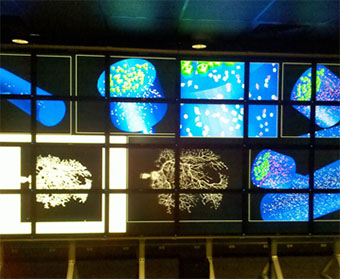
Images of the cells Fidel Santamaria works on in his UTSA lab.
(Oct. 8, 2018) -- It’s about the size of a dinner table; yet, one day may influence conversations held around the kitchen table. This is what excites researchers at UTSA as they anticipate the arrival of a state-of-the-art microscope. This device, known to a very select few, as a two-photon holographic microscope, will be used to write commands directly into neurons, including human, and get us closer to understand disorders such as Autism, which affects so many families in the United States today.
“It’s the Bentley of microscopes,” says Fidel Santamaria, an associate professor in the department of biology and computational neuroscientist at UTSA. “It’s built by hand, piece by piece.”
According to Santamaria, there are about two dozen of these microscopes in the world. The National Science Foundation and UTSA awarded close to $840,000 towards the technology. One main reason UTSA won is because the team, assembled by Santamaria, that will have access to the device is diverse, spanning a broad range of topics across multiple disciplines, with neuroscience the main focus.
It is estimated that a single neuron has about 10,000 synapses to communicate with another neuron, and yet much neuroscience is still focused on stimulating larger regions of the brain, known as bulk stimulation. According to Santamaria, this is a method with limitations that the new microscope will be able to address.
“In our case, we will have microscopic precision to activate specific pathways in the brain. Only when we have control and know the type of information that we are ‘writing in’ the circuitry of the brain and ‘read out’ the activity of the neurons, then we will be able to truly understand how the nervous system works,” says Santamaria.
In two-photon holographic microscopy, a powerful laser is used to project a movie in 3D of the researcher-programmed neural stimulation (or inputs) unto networks of neurons in living tissue. Simultaneously, a second laser is used to record the response of the neurons to this stimulation. Through this process, it will then be possible to determine how the nervous system, in health and disease, transforms inputs-into-outputs.
Obtaining this microscope required a multi-disciplinary team across the College of Science and Engineering. Santamaria collaborated with Gabriela Romero Uribe, from biomedical engineering, to secure the winning grant. The activities of this award will promote multi-disciplinary science communication proficiency of undergraduate and graduate students at UTSA. There will be opportunities for students to understand state-of-the-art microscopy techniques and build multi-media accessible information to be made available to the general public. The device will be a catalyst to promote interactions among groups across campus and serve other initiatives such as the Brain Health Consortium of UTSA.
This new technology will help understand how the contribution of incorrect wiring impacts the function of certain regions of the brain.
“We can activate the connections between neurons, known as synapses. More importantly, we can train neurons to respond to a specific pattern of synaptic activity. In that way, writing in a memory into the circuit,” says Santamaria.
UTSA is ranked among the nation’s top five young universities, according to Times Higher Education.
Visit Fidel Santamaria’s lab to learn more about an upcoming international symposium he is co-organizing taking place in San Antonio, where thought leaders will gather to develop new theories on brain function.
Learn more about the UTSA Neurosciences Institute.
Learn more about the UTSA Brain Health Consortium.
Learn more about Gabriela Uribe’s work.
Connect with UTSA online at Facebook, Twitter, YouTube, Instagram and LinkedIn.
UTSA Today is produced by University Communications and Marketing, the official news source of The University of Texas at San Antonio. Send your feedback to news@utsa.edu. Keep up-to-date on UTSA news by visiting UTSA Today. Connect with UTSA online at Facebook, Twitter, Youtube and Instagram.
Move In To COLFA is strongly recommended for new students in COLFA. It gives you the chance to learn about the Student Success Center, campus resources and meet new friends!
Academic Classroom: Lecture Hall (MH 2.01.10,) McKinney Humanities BldgWe invite you to join us for Birds Up! Downtown, an exciting welcome back event designed to connect students with the different departments at the Downtown Campus. Students will have the opportunity to learn about some of the departments on campus, gain access to different resources, and collect some giveaways!
Bill Miller PlazaCome and celebrate this year's homecoming at the Downtown Campus with food, games, giveaways, music, and more. We look forward to seeing your Roadrunner Spirit!
Bill Miller PlazaThe University of Texas at San Antonio is dedicated to the advancement of knowledge through research and discovery, teaching and learning, community engagement and public service. As an institution of access and excellence, UTSA embraces multicultural traditions and serves as a center for intellectual and creative resources as well as a catalyst for socioeconomic development and the commercialization of intellectual property - for Texas, the nation and the world.
To be a premier public research university, providing access to educational excellence and preparing citizen leaders for the global environment.
We encourage an environment of dialogue and discovery, where integrity, excellence, respect, collaboration and innovation are fostered.